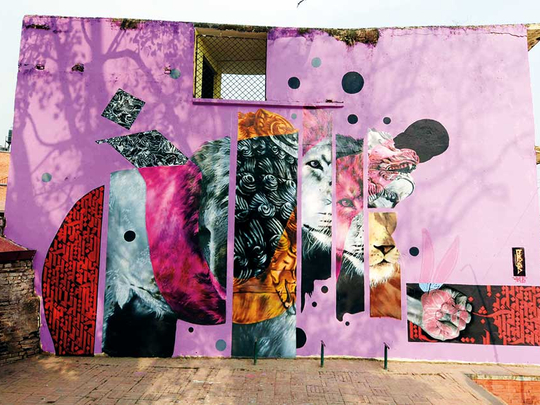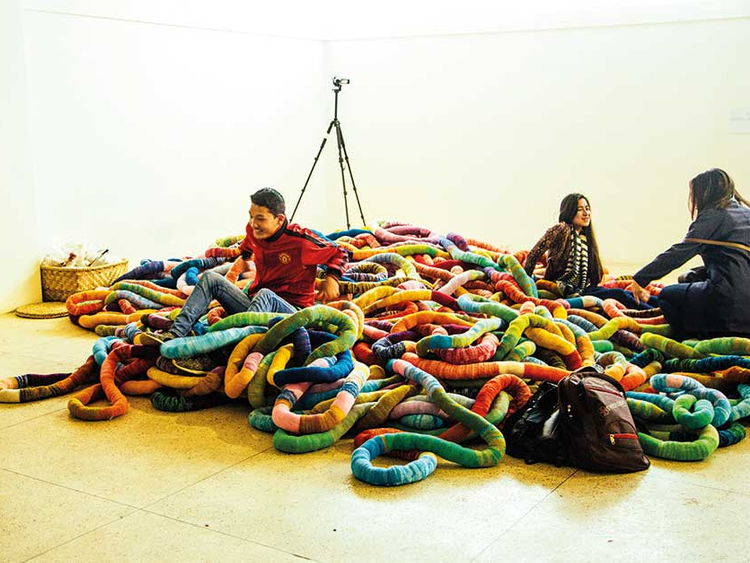
Following the devastating earthquake in Nepal in 2015, the country is still rebuilding its damaged infrastructure as well as the morale of its people. The inaugural Kathmandu Triennale (KT 2017), that opened on March 24 and will run until April 9, is dedicated to the victims of the earthquake, and aims to contribute in the rebuilding process by engaging the community with art through a variety of exhibitions inspired by the local culture, landscape and relevant social issues along with an arts educational programme for youngsters designed to have a long tern impact nationally.
KT 2017 is organised by the Siddhartha Arts Foundation, Kathmandu and the Museum of Contemporary Art, in Gent, Belgium (S.M.A.K.) with support from the Saraf Foundation. It is curated by Philippe Van Cauteren, artistic director of S.M.A.K., and presents an exhibition featuring works by more than 50 artists from 25 countries based on the theme My City, My Studio / My City, My Life.
Eminent artists participating in KT 2017 include Alice Fox (UK), Bart Lodewijks (Netherlands), Carole Vanderlinden (Belgium), Francis Alÿs (Mexico), Heide Hinrichs (Germany), Javier Tellez (Venezuela), Kader Attia (France), Lee Kit (Hong Kong), Mahbubur Rahman (Bangladesh), Majd Abdel Hamid (Palestine), Masae Suzuki (Japan), Massimo Bartolini (Italy) and Nepali artists such as Bhuwan Thapa, Bikash Shrestha, Jupiter Pradhan, Kiran Maharjan, Laxman Bazra Lama and Manish Lal Shrestha.
The artists were invited to contemplate the relationship between art, the city and its heritage, by making the city their studio, and creating works inspired by the blend of ancient traditions and modernity in this beautiful city and the cultural, social and political changes happening in the city.
Most of them have created new commissioned site specific works for the four main exhibition venues which include Patan Museum, an ancient royal palace now housing a museum of traditional, handmade religious objects; Siddhartha Arts Gallery, which showcases contemporary Nepalese art and was co-founded by Sangeeta Thapa, chairperson of KT; Taragaon Museum, designed by Austrian architect Carl Pruscha, showcasing ethnographic photography, architectural drawings of Nepal’s heritage, maps, old landscapes and urban sketches; and Nepal Art Council, the country’s official exhibition space for contemporary art.
Some of the works directly address the notion of the city, reflecting elements of urbanism and architecture, while others contemplate the city as a social organisation, a living and changing organism built by people of different social and cultural backgrounds. The artworks include a series of drawings of the Birds of Nepal; an installation featuring bits of paper with the names of various Nepalese villages; and murals depicting the wrath of nature, and the spirit and resilience of the Nepalese in facing tough challenges.
The organisers have placed great emphasis on arts education. Over the last few months, various organisations and art collectives have been working on an outreach programme for children and youth at schools in Kathmandu, which includes workshops and interactive sessions with Nepalese and international artists, attended by over 1500 participants.
KT 2017 is also hosting several independent exhibitions by institutional partners from Qatar, Bangladesh, UK, Finland, Poland and Australia. These include ‘City/Home: Built/Unbuilt’ — an exhibition that brings together Kathmandu-based artists and artists from Doha with migrant Nepali workers in Qatar to explore ideas of identity, home, belonging, migration, labor and memory and ‘Treasure of Nepal’, an exhibition produced in collaboration with the Lahti Museum of Art in Finland that documents Nepalese craftspeople in the intimate spaces where they work in the city of Kathmandu, with includes portraits of the artisans and their creations.














